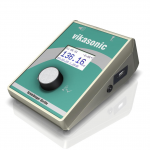Manufactured by: Schleibinger Gerate
Measuring the Early Setting and Hardening with Ultrasonic Waves
The early setting is usually measured with the penetrometer or the Vicat apparatus. This kind of measurement has some disadvantages. In the early sixties some researchers suggested to use the ultrasonic transition time as method for measuring the setting of mortars or fresh concrete. In cooperation with a German dry mix company, Schleibinger developed a special ultrasonic unit with an integrated datalogger and a special designed setup for the mortar specimen.
Measurement Principle
Fresh mortar is setting between two ultrasonic transducers, which are supplied with 0.25s or less pulses per second at a frequency of 54 kHz. The mortar changes, according to the setting, the ultrasonic transition time. From the beginning of first contact of the growing binder-stone, the ultrasonic sound speed increases. If there is a complete crystalline structure the change of the sound speed will be slower. Until the a further aggregation of the cement stone it increases again.
Measurement Setup
Each measurement cell is supplied with a pair of ultrasonic transducers. The Vikasonic continuously measures the ultrasonic transition time and the signal damping. The data sets are recorded digitally to a common USB stick. Also the sound speed and the elastic modulus is calculated and recorded. Additionally the temperature inside the specimen is measured with a type K thermocouple.
The Schleibinger Vikasonic is an autonomous instrument, during the tests no PC is required. . The data may be directly imported into your Excel worksheet. The software was developed at Schleibinger and may be adapted to your special requirements.
Standards
NF P 98-231-5 Comportement au compactage des materiaux d’assises autres que traits aux liants hydrocarbons. (Tests relating to pavements – Compaction tests on non-bituminous materials – Part 5 : Workability time limit determination of granular materials bound with cementitious binders using sonic examination.) AFNOR, April 1997.
BS 1881: Part 203 : Testing Concrete – Recommendations for measurement of velocity of ultrasonic pulses in concrete.
ASTM C 597-83 Standard Test Method for Pulse Velocity through Concrete
Additional Product Information:
| Item | Size | Download |
|---|---|---|
| Product Brochure | 325kb | Download |
| Product Specifications | 254kb | Download |
To download and view these attachments you must have Acrobat Reader. If you do not have Acrobat Reader, click the “Get Adobe Reader” button.

